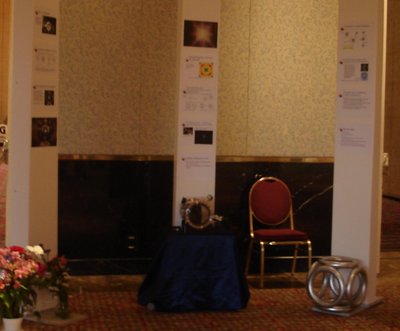We are developing the social individualist meta-context for the future. From the very serious to the extremely frivolous... lets see what is on the mind of the Samizdata people.
Samizdata, derived from Samizdat /n. - a system of clandestine publication of banned literature in the USSR [Russ.,= self-publishing house]
|
Al Gore, call your office:
Forecasters are predicting a cold and windy Easter weekend, with snow, gales and heavy downpours in some regions. With snow expected to blanket the north, temperatures will drop as low as -8C in some areas, with particularly treacherous conditions possible over the Scottish mountains.
From the Independent newspaper, ironically one of the most vociferous advocates of the idea that the Earth is doomed from global warming, killer bees or whatever.
Of course, as Dale Amon said the other day, it makes sense to think how free marketeers should address the question of “what if man-made global warming really is a problem?” rather than just poke fun at it, as I am doing here. Dale is right, of course, just in the same way that advocates of civil liberties need to recognise that we face a terrorist threat and not, as one or two libertarians of my acquaintance can do, deny it. Changing ocean currents, caused by movements in the Arctic ice shelf, might, for example, explain why the Gulf Stream is not working its balmy magic on the British climate this time of year. But you can see how perplexing all this must be to people constantly harangued about the need to drastically cut down on carbon usage. The earth does not seem to be getting hotter, at least not around here. It is bloody cold, in fact. But then, my parents and grandparents will point out to me that Easters have often been terrible in the past; they can even remember it snowing in late April.
Sometimes I wonder whether the news editors in the media “join the dots”, to coin a phrase. Scanning my Bloomberg machine this morning (part of my day job), this headline was prominent:
Chicago’s Snowiest Winter Since 1979 Depletes Budget
Then, on the same Bloomberg front page, is this:
Gore Invests $35 Million for Hedge Funds With EBay Billionaire
Gore has, of course, made himself a mint and also burnished his Green credentials with his film, An Inconvenient Truth, a film that has had great influence in encouraging the idea that the Earth is at serious risk from man-made global warming, although others remain to be convinced. Fair play to Gore: if he has managed to make a lot of cash by producing a film and persuaded enough paying customers to see it, well who am I, as an ardent capitalist, to complain? If he wants to invest in those mysterious-sounding things called hedge funds, even better (they are not all that bizarre, by the way, just a form of investment fund with a few tricks). But if the city of Chicago is running short of cash to pay for all the snow clearance, maybe the councillors should phone up Al and ask for a donation. After all, the current freezing weather in so many places must be er, Man’s fault, right?
It sounds like one of those three decker jokes where part three brings you down to earth with a bump, which is presumably why it got written like that. Hedge your bet by hinting that the story could be all rubbish, and then tell it anyway. Because, maybe he’s right:
BOSTON – He predicted the fall of the Soviet Union. He predicted the explosive spread of the Internet and wireless access.
Now futurist and inventor Ray Kurzweil is part of distinguished panel of engineers that says solar power will scale up to produce all the energy needs of Earth’s people in 20 years.
There is 10,000 times more sunlight than we need to meet 100 percent of our energy needs, he says, and the technology needed for collecting and storing it is about to emerge as the field of solar energy is going to advance exponentially in accordance with Kurzweil’s Law of Accelerating Returns. That law yields a doubling of price performance in information technologies every year.
Tell me more:
… advances in technology are about to expand with the introduction of nano-engineered materials for solar panels, making them far more efficient, lighter and easier to install. …
Is anyone serious now interested in this, other than singularity prophets?
… Google has invested substantially in companies pioneering these approaches.
Okay, but I would have preferred an obscure venture capitalist with a boring name, rather than the overmighty corporation which is, for now, flavour of the decade, and which has, for now, more money than God, to the point where hundreds can have full-time jobs spending it, without making a visible dent in money mountain. How “substantially” has Google invested?
The reason why solar energy technologies will advance exponentially, Kurzweil said, is because it is an “information technology” (one for which we can measure the information content), and thereby subject to the Law of Accelerating Returns.
“We also see an exponential progression in the use of solar energy,” he said. “It is doubling now every two years. Doubling every two years means multiplying by 1,000 in 20 years. At that rate we’ll meet 100 percent of our energy needs in 20 years.”
So, could any of this be true? If it is true, what follows, economically, politically etc.? Beyond the obvious in the shape of disconsolate arabs. Instapundit doesn’t have comments, but we do. My first thought: batteries for laptops and mobile phones are going to be replaced by infinitely powerful black patches on the outside (that’s already happened with calculators, has it not?). Second thought: will big black patches on the roof in due course be enough to power cars? Trains? Lorries? Airplanes? Spaceships?
Third thought: the greenies will absolutely hate this, because there’s nothing they hate so much as technical fixes to their precious and previously unfixable problems. Predictions for what they will say: “The sun is a finite resource! It is running out! Stop consuming Our Fragile Sun! …” And, suddenly they will fall in love with oil industry workers, because they won’t be needed any more.
But, first things first. Is it true?
I do not normally like receiving emails selling me products, but I thought I would have to make an exception for this:
Dear Antoine,
Virgin Galactic is delighted to announce a new destination… space. Climb to 360,000ft. at a cruising speed of almost three times the speed of sound, in unprecedented levels of safety and comfort. See our beautiful planet from 63 miles up and experience the magic of weightlessness.
Redeem 200,000 miles to receive 10% off the cost of a spaceflight, that’s an incredible $20,000 saving!* Join our future astronauts and book your place in history.
I look forward to the Nigerian version:
“My name is Mr.Moses Odiaka. I work in the credit and accounts department of Union Bank of NigeriaPlc,Lagos, Nigeria. I write you in respect of a foreign customer with a Virgin Galactica ticket. His name is Engineer Manfred Becker. He was among those who died in a plane crash here in Nigeria during the reign of late General Sani Abacha.
Since the demise of this our customer, Engineer Manfred Becker, who was an oil merchant/contractor, I have kept a close watch of the deposit records and accounts and since then nobody has come to claim the airmiles in this a/c as next of kin to the late Engineer. He had only 18.5mllion air miles in his a/c and the a/c is coded. It is only an insider that could produce the code or password of the deposit particulars. As it stands now,there is nobody in that position to produce the needed information other than my very self considering my position in the bank.”
Somewhat over a week ago I did a posting here about maths. What use, I asked, is it? I always knew there were plenty of good answers, but the quantity and quality of what the Samizdata commentariat came up with amazed and delighted me, as it did a number of those same commenters. Someone even suggested we have other postings here about what use other educationally controversial things are, like poetry, Latin, and so on (I am thinking: media studies, which I definitely do not assume would have to be useless).
At the end of that piece I mentioned that Michael Jennings and I were about to record a conversation on this subject. Its been up and listenable to at my Education Blog for a while now, so apologies for the delay in mentioning it here, but far better a week late than never. This is not the kind of thing that will be going out of date any time soon. Here is the link to it.
I did most of the asking, and Michael did most of the answering, and it must be admitted that Michael is not what you would call a hundred per cent fluent speaker. It sounds like he suffers from the mild remnants of a childhood stutter, which means that he would not be the ideal choice to perform on Just A Minute, a BBC 4 radio show where your mission is to talk uninterrupted nonsense and where you get penalised for the slightest suggestion of hesitation or repetition. For, on the plus side, Michael does not do nonsense either, which is part of the reason why he still often hesitates. He wants to get things right. Basically, the man just knows so much, about so many things, which means that when he answers a question he is as likely as not choosing between four or five equally relevant facts that he might then serve up. You can see why the people in the City of London get so rich, if they have people like Michael keeping them informed about the world and its business. I strongly urge anyone who resents even the hint of a lack of verbal fluency to, as the Americans say and pardon my split infinitive, deal with it. I found my talk with Michael about maths and its uses absolutely fascinating. Word of mouth already tells me that others have liked listening to it also, and I know that many more will if they click on the above link.
The delay in telling Samizdata readers about this recorded conversation enables me also to mention here another such conversation involving Michael Jennings that has been more recently immortalised by another of London’s libertarian recording angels (so to speak), Patrick Crozier. This time, the subject is aviation, landing slots at Heathrow, international aviation treaties, and the like. If you have any doubts about Michael’s credentials as an expert on this industry (which of course could never have got off the ground without the relentless application of mathematics), then do what Patrick Crozier suggests and have a(nother?) read of this Samizdata posting from way back, on this same subject. Sadly, there was a mix up with the first attempt to record all this (might Patrick perhaps benefit from a media studies course?). The first conversation got stopped in mid flight through a wrong button getting pressed, and a separate concluding recording was done. But here they both are, and they are both well worth listening to. Patrick’s brief bloggery about them is to be found at Transport Blog, here and here.
By the way, Patrick Crozier and I seem to have very divergent ideas about what is the correct volume at which to record these things, so be ready to do some nob twiddling if you go from one to the other. Technical comments about which of us got it wrong (both I dare say) and by how much would be very welcome. More media studies.
Getting back to what was said, there are many delightful moments in these discussions, especially in the maths one, which I would say, wouldn’t I? Nevertheless, my absolute favourite bit of all happens towards the end of the first of the two aviation conversations, a soundbite which Patrick also featured on the short trailer that he did for that. The dialogue goes like this:
Patrick: “Can you trade your slots?”
Michael: “Er … kind of. Not legally. Well, sort of.”
There are times when hesitation is the most eloquent thing there is. Listen, and all is explained.
It has been rather cold lately in different parts of the world. As this gentleman points out, if worries about man-made global warming can cite the early appearance of flowers or migrant birds in support of their case, the argument cuts both ways. In case any supporters of the man-made global warming thesis get sniffy about this point, I am not a ‘denier’ of the thesis: I think there is some evidence that it may be happening. The trouble is that my views are coloured by the fact that supporters of it tend to support a Big Government agenda. And frankly, I see an awful lot of dodgy investment ideas being sold on the basis of encouraging ‘Green’ technology.
I am looking forward to the first article, meanwhile, that tries to blame Britain’s earthquake this week on human activity. Take a good look at the British Geological Survey website: it is fascinating. Apparently, there have been even been quakes in Norfolk. Norfolk, fcrissakes.
And it is The Economist. Unlike some of my fellow Samizdatistas, I am a fan [1]. But then, I am a liberal – conservative only in my suspicion of social management and ‘fixing’ things without enquiry as to whether they are actually broken.
This week in the print edition there is an excellent supplement: The electronic bureaucrat (introduction here). It is clear-sightedly critical of e-government of all kinds, without falling into the know-nothing technophobic rants that I fear some of those who oppose the database state do:
[G]loom, fear and optimism are all justified.
[1] Though I sincerely hope putting Martin Sheen on the cover of the Intelligent Life quarterly was one of its deadpan jokes.
Newsreaders still feel it is worth a special and rather worrying mention if, for instance, a crime was planned by people ‘over the Internet.’ They don’t bother to mention when criminals use the telephone or the M4, or discuss their dastardly plans ‘over a cup of tea,’ though each of these was new and controversial in their day.
– Douglas Adams quoted (last month but who cares?) by Kevin Marks
Every so often I have one of those ain’t-capitalism-grand? moments, and I just had another:
It’s like we can’t make it through the week these days without word of some outlandish memory technology solving all worldly ills; but it’s not that we’re complaining. This week’s featured tech comes from Nanochip, and promises gains in storage quantity and cost per chip over flash memory. The first prototypes will store 100GB, and will be shipped to device makers next year for evaluation. Nanochip technology stores data on a thin-film material, and accesses it using microscopic cantilevers. Each bit will be 15 nanometers wide at first, with theoretical sizes as small as a couple nanometers. Speeds will be near that of flash, and the data could last longer. There are still some obstacles to accessing the data efficiently, but luckily Nanochip just scored $14 million in funding to complete its pursuit. IBM has been pursuing a similar tech since the late 90’s.
Flash memory being the kind of memory you can drop on the floor, and still get at. Here‘s the story that engadget is linking to.
Yesterday, capitalism was great too. I finally got my hands on, and immediately bought, for a mere £220, one of these. Is the Eee PC about to be capitalism’s next triumph?, I asked back then. Definitely one of them, I would say. It has hardly any memory built in, certainly no nano-magic like that described above, but it does have an SD card slot, and it is very cute, and very small, and very light, yet very solid, and I love it.
In a recent article I noted my surprise at the apparent progress made in fusion by the Bussard team and stated I had not heard of them before.
it turns out I was wrong. I did indeed run across them before but the importance did not register so it did not stick in my consciousness. I even have a photo:

EMC2 exhibit at the 2007 International Space Development Conference in Dallas.
Photo: copyright Dale Amon, All Rights Reserved
In my defense, I am rather occupied with Society management duties at these events so I do not have much unscheduled time to talk to exhibitors.
What are millionaires for? Why, to pay for things like this:
Gizmodo’s Martin Lynch writes:
A UK designer is about to take the wraps off a unique floating chair/recliner called The Lounger, inspired by the Landspeeder from Star Wars.
Designed by 40-year Keith Dixon from Middleton, the futuristic looking Lounger has taken 5 years to create and allows you to float above the base thanks to the use of repelling magnetic forces in the base and the lounger itself.
We are not talking a few centimetres off the base either but up to 14ins so that you get that whole ‘floating sensation’. That of course depends on how much you weigh. If you’re close to the 266lbs [19 stone] limit then maybe you should drop that to 4ins or less.
There are restraining rods to prevent the seat from shooting off to the sides and users are warned to keep it at least 5 feet from the telly. And make sure you don’t have a pacemaker.
Apart from that, you’re good to float from March 16 when The Lounger goes on sale for a cool £5,875. That should bring some people back to Earth with a bump.
Which is why I mention the millionaires. The millionaires will decide whether they think this is a cool idea. If they decide that it is, some of them will buy it, thus paying for about an eighth of the research and development costs. If the ones that buy it like it, more millionaires will buy it, thus paying for another quarter of the R and D. Many more chairs will then be made, for sale at a rather lower price, slightly better. Pretty soon, we’ll all be able to buy them, either at Ikea or at Curry’s, for £99.99 a pop, and half a decade later for £34.99, with additional features that the early adopter millionaires never dreamed of.
Why can’t schoolznhospitalz be done more like this and less the way they are now?
I’m seriously considering pitching a detective novel, about the hunt for a serial killer. The unique selling point will be that as the detective homes in on the killer, he gradually comes to sympathize with him, and ends up questioning whether he should actually collar the murderer … because the victims are all spammers.
– Charlie Stross
|
Who Are We? The Samizdata people are a bunch of sinister and heavily armed globalist illuminati who seek to infect the entire world with the values of personal liberty and several property. Amongst our many crimes is a sense of humour and the intermittent use of British spelling.
We are also a varied group made up of social individualists, classical liberals, whigs, libertarians, extropians, futurists, ‘Porcupines’, Karl Popper fetishists, recovering neo-conservatives, crazed Ayn Rand worshipers, over-caffeinated Virginia Postrel devotees, witty Frédéric Bastiat wannabes, cypherpunks, minarchists, kritarchists and wild-eyed anarcho-capitalists from Britain, North America, Australia and Europe.
|





